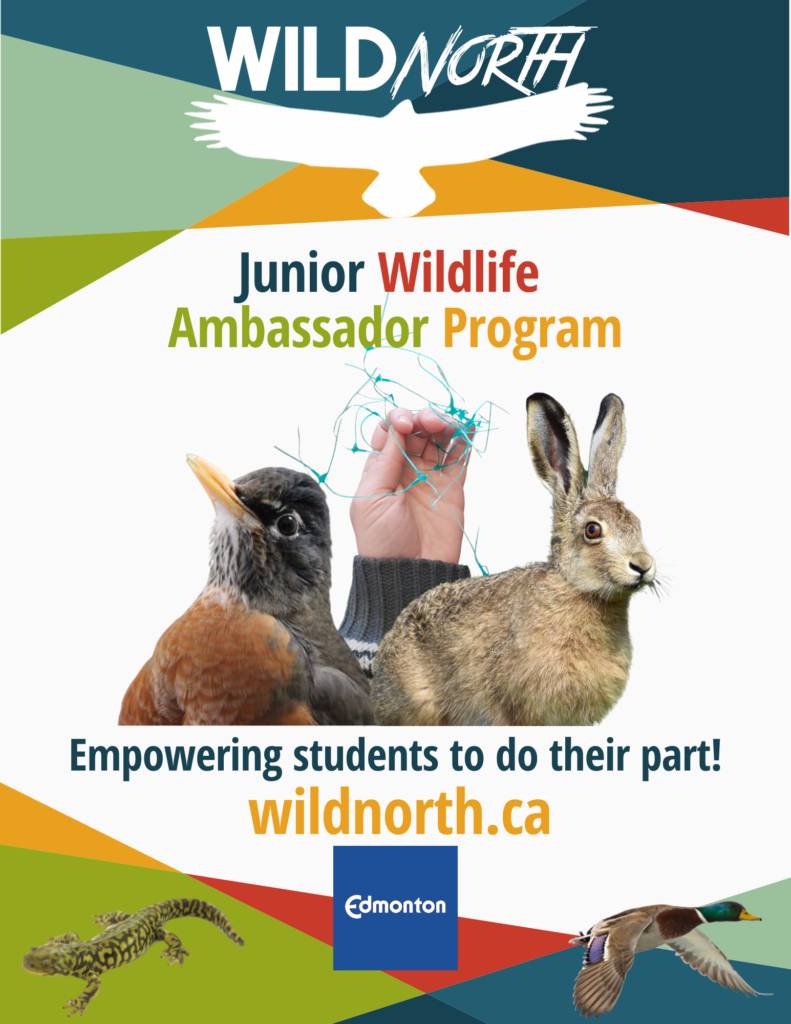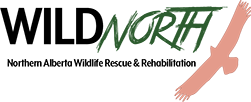The Junior Wildlife Ambassador Program is back for the 2024-2025 school year!
Your students can become Junior Wildlife Ambassadors through an online virtual presentation.
We are fully booked for 2024, please take a look at our 2025 availability.
To book for the 2024-2025 school year, please head to our booking site
The Junior Wildlife Ambassador Program (JWAP) is an education program, whereby WILDNorth educates elementary students on the importance of wildlife in our community and empowers each student to take action in their own community. WILDNorth offers free, curriculum-specific presentations for Grades 3, 4, 5, and 6 in Edmonton thanks to Capital City Cleanup. There is a cost of $80 to book this presentation for schools outside of Edmonton. Please note that we do have reduced capacity as we update our programming to align with the new curriculum.

Grade 3 – “Food Chains, Wildlife, & My Community”
This 45-minute presentation is designed to introduce Grade 3 students to the intricate relationships between animals, plants, and their environment. Students will learn about food chains, how energy moves through the environment, and explore a food web using examples of local wildlife and vegetation. Linked directly to the Living Systems unit, this program offers a fun and tangible way for students to learn how plants and animals interact with one another while developing an awareness and appreciation for backyard nature.
Learning Outcomes:
- Develop a foundational understanding of food chains, food webs, and how energy moves through our environment
- Explore the roles of animals and plants within local ecosystems; understand the difference between herbivores, carnivores and omnivores
- Analyze and understand how plants and animals interact with one another
- Understand the importance of creating a clean and safe environment, and identify actions that can be taken to protect plants, animals and habitats within our community
Grade 4 – “Litter, Wildlife, & My Community”
Since a clean community is a shared responsibility, WILDNorth and Capital City Clean Up have joined forces to deliver the “Litter, Wildlife & My Community” classroom program. Educational and entertaining, this 60-minute presentation directly links to the Waste and Our World unit. It illustrates how litter harms wildlife and helps students identify actions they can take to minimize litter’s impact on wildlife.
Learning Outcomes:
- Recognize how human activity and the waste we produce affects wildlife
- Identify types of waste harmful or toxic to wildlife and our ecosystems
- Identify actions they can take to minimize the impact of waste on wildlife
Grade 5 – “Body Systems, Wildlife, & My Community”
This 60-minute presentation is designed to introduce Grade 5 students to the fascinating world of animal anatomy, diving into the body systems that support survival in the wild. Students will explore how the digestive, respiratory, circulatory, and musculoskeletal systems function in different animals, including birds, mammals, reptiles and amphibians. This program offers an engaging way for students to understand the vital processes that allow animals to thrive in their environments while fostering a sense of responsibility for protecting local wildlife.
Learning Outcomes:
- Develop a foundational understanding of the digestive, respiratory, circulatory, and musculoskeletal systems in various wildlife species.
- Explore how these systems support the survival and adaptation of animals in their natural habitats.
- Analyze and compare the internal systems of birds, hares, snakes, and frogs, understanding how each is uniquely adapted to its environment.
- Understand the importance of maintaining a clean and safe environment for wildlife, and identify actions that can be taken to protect animals and their habitats within our community.
Grade 6 – “Ecosystems, Wildlife, & My Community”
This 60-minute presentation is designed to deepen Grade 6 students’ understanding of ecosystems, the complex interactions that sustain them, and the vital role wildlife plays within them. Students will investigate the characteristics and components of ecosystems, focusing on the intricate relationships between animals, plants, and their environment. This program offers an engaging exploration of local ecosystems, including forests, wetlands, and grasslands, while highlighting how Alberta’s wildlife are specially adapted to their habitats. The presentation also emphasizes the importance of protecting these ecosystems from threats like litter and pollution to ensure the survival and wellbeing of local wildlife.
Learning Outcomes:
- Develop a foundational understanding of ecosystems, including biotic and abiotic components, and how they interact.
- Explore specific ecosystems in Alberta and examine how animals like elk, bobcats, and American pelicans are uniquely adapted to their environments.
- Analyze the impact of human activities, such as littering, on the balance of ecosystems and the health of wildlife.
- Understand the role of individuals in protecting ecosystems and identify actions that can be taken to minimize negative impacts on the environment and local wildlife.
For inquiries, email education@wildnorth.ca

